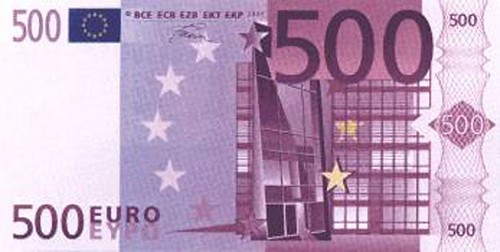
PREV ARTICLE
NEXT ARTICLE
FULL ISSUE
PREV FULL ISSUE
THE 500 EURO BIN LADEN BANKNOTE
This Wall Street Journal blog article debates the merits of the 500 Euro banknote and discusses their nickname in Spain.
-Editor

Spaniards call them Bin Ladens, and at the height of financial crisis in the fall 2008, it was the Bin Ladens that saved the day, says the former banknote chief for the European Central Bank. Bin Ladens are the €500 banknotes. The joke about them being Bin Ladens surfaced in Spain four years after the euro banknotes were introduced in January 2002. It played on the fact while everyone in Spain had heard about the big bill, nobody supposedly had seen one — even though it was reported that roughly a quarter of all €500 notes in the euro area circulated in Spain. The joke has become outdated due to the snuffing out of Osama bin Laden. However, the debate whether the €500 bill should be eliminated lives on. The reason: critics say it is a boon to drug traffickers, money launderers and tax evaders. The logic is simple. For $1 million in cash you need ten thousand $100 bills. With the €500 note, you need only about 1,450 banknotes for the same amount in cash at the current exchange rate. Handy if you need to store or transport big amounts of illicit cash. Thus the €500 should be withdrawn, goes the argument. The debate is as old as the €500 note itself, recalls Antti Heinonen who was present at its creation. Mr. Heinonen chaired in 1996-1998 the EMI’s subcommittee which was tasked with creating the euro banknotes. EMI was the European Monetary Institute, the forerunner of the ECB. From 1998 to 2008 he served as Director of Banknotes at the ECB, and was the point man at the introduction of euro banknotes in 2002. The merits of high-value notes were debated in planning sessions, Mr. Heinonen said last week at the launch event for his new Finnish language book about the history of the first euro banknotes. There were six countries with banknotes whose value exceeded €200: Holland, Belgium, Italy, Austria, Luxembourg and Germany with the most valuable high-denomination bill of them all, the 1,000 Deutsche Mark banknote valued at about €510. As Mr. Heinonen recalled, representatives from these countries became upset when it was suggested that the high value banknotes helped the underground economy. Defenders of the €500 note said that in some countries people preferred to keep savings in cash because they trusted it more than banks, Mr. Heinonen said. That settled it. As for the legitimate uses for the €500, Mr. Heinonen mentioned one: a stabilizer during a financial crisis. After the collapse of Lehman Brothers in 2008, public’s faith in banks wavered in many countries, sending people to exchange their savings for cash. Demand for the euro banknotes surged in and outside the euro area. “We could have not handled it without the €500 note,” Mr. Heinonen said.
To read the complete article, see:
During Crisis the €500 Note, Beloved by Criminals, Saved the Day
(blogs.wsj.com/economics/2014/03/17/during-crisis-the-e500-note-beloved-by-criminals-saved-the-day/)
The Numismatic Bibliomania Society is a non-profit organization promoting numismatic literature. See our web site at coinbooks.org. To submit items for publication in The E-Sylum, write to the Editor at this address: whomren@gmail.com To subscribe go to: https://my.binhost.com/lists/listinfo/esylum All Rights Reserved. NBS Home Page Contact the NBS webmaster 
|